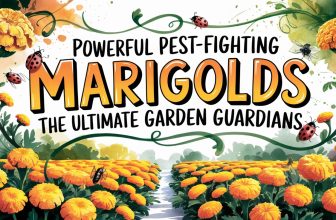Discover the Secret Life of Geraniums
Geraniums, often considered a staple in gardens and landscapes, encompass a vast and intricate world that goes beyond the surface beauty of their blossoms and foliage.
The Genus Pelargonium alone presents a multitude of species, each with its own unique traits and growing requirements, offering a captivating exploration into the realm of horticulture.
From the alluring scents of the various geranium species to the distinct characteristics of cranesbill geraniums, there is a wealth of secrets waiting to be unveiled.
As we journey into the secret life of geraniums, a deeper understanding of their diversity and complexities emerges, setting the stage for a compelling exploration of their world.
The Diversity of Pelargonium Species
The diversity of Pelargonium species is evident in the wide range of characteristics, including varying leaf shapes, flower colors, growth habits, and scents, making them versatile and appealing to a broad spectrum of gardeners.
Propagation techniques for Pelargonium include seed germination, stem cuttings, and division.
Medicinally, Pelargonium species are known for their essential oils, which have been traditionally used to treat various ailments such as respiratory infections, digestive issues, and skin conditions. The leaves of some scented geraniums are used in teas and desserts.
These plants have garnered attention for their potential pharmaceutical applications due to their antibacterial, antifungal, and anti-inflammatory properties.
The rich diversity of Pelargonium species offers not only aesthetic appeal but also potential therapeutic benefits, making them a valuable addition to any garden.
Growing Requirements for Zonal Geraniums
The wide diversity of Pelargonium species, with their various leaf shapes, flower colors, and growth habits, necessitates an understanding of the specific growing requirements for zonal geraniums.
Zonal geraniums, known for their vibrant flowers and attractive foliage, thrive with at least a few hours of direct sunlight. To ensure optimal flowering, it is essential to provide them with the right conditions.
Troubleshooting common issues such as yellowing leaves or poor flowering can often be attributed to overwatering or insufficient sunlight. Additionally, best practices for fertilizing zonal geraniums involve using a balanced, water-soluble fertilizer every 4-6 weeks during the growing season. Avoid excessive fertilization, which can lead to salt buildup in the soil.
Exploring Scented Geranium Varieties
Exploring the wide range of scented geranium varieties offers gardeners an opportunity to enjoy a plethora of delightful fragrances such as rose, lemon, chocolate, and citronella, each adding a unique sensory experience to the garden.
Propagating scented geraniums can be achieved through stem cuttings and division, making it easy for enthusiasts to expand their collection.
Beyond their aromatic appeal, scented geraniums are valued for their therapeutic uses, with different varieties offering diverse benefits such as stress relief, insect repellent properties, and culinary applications.
These versatile plants thrive in containers and garden beds, enhancing outdoor spaces with their enticing scents.
With proper care, scented geraniums can flourish as perennials in suitable climates, providing long-lasting aromatic enjoyment and practical advantages.
Care Tips for Ivy-Leaved Pelargoniums
Amid the diverse array of Pelargonium species, attention now turns to the care tips for Ivy-Leaved Pelargoniums, renowned for their trailing nature and suitability for hanging baskets, providing an interesting shift from the exploration of scented geranium varieties.
Caring for ivy-leaved pelargoniums involves providing well-draining soil, ample sunlight, and regular watering, allowing the soil to dry slightly between waterings to prevent root rot. These pelargoniums thrive in zones 10 or higher, but in colder climates, they can be brought indoors during winter or treated as annuals.
When selecting the best hanging basket varieties, consider options like Tornado, Cascade, or Tumbling Cascade for their vigorous growth and abundant blooms. Regular deadheading of spent flowers and occasional fertilization can help maintain their lush appearance and continuous flowering, making them an ideal choice for cascading displays.
Characteristics of Cranesbill Geraniums
Known for their resilience and beautiful blooms, Cranesbill Geraniums, belonging to the genus Geranium, boast a wide range of captivating characteristics.
These hardy perennials, thriving from zone 3 and upward, prefer part shade and well-drained fertile soil.
When it comes to propagation methods, Cranesbill Geraniums can be easily propagated through division or from seeds. Division should be carried out in early spring or fall, while seeds can be sown directly in the garden after the last frost.
While these geraniums are generally resilient, common pests such as aphids, spider mites, and caterpillars may pose a threat. Regular inspection and appropriate pest control measures can help in mitigating these issues, ensuring the healthy growth of these stunning plants.
Overwintering Tender Geraniums
To successfully overwinter tender geraniums, it is essential to take appropriate measures to protect them from the cold and ensure their survival for the following growing season.
Here are key overwintering techniques for preserving geraniums:
- Indoor Overwintering: Bring potted geraniums indoors before the first frost. Place them in a cool, dark area with temperatures around 45-50°F (7-10°C). Water sparingly to prevent rot.
- Outdoor Overwintering: In regions with mild winters, geraniums can be left outdoors with some protection. Mulch around the base of the plant and cover with a layer of pine boughs or straw.
- Storage Preparation: Before overwintering, prune the geraniums back to about half their size. Inspect for pests and diseases, and treat if necessary.
Cultivating Zonal Geraniums
Cultivating Zonal Geraniums begins with understanding the specific care and growing conditions necessary for these popular Pelargonium plants, building upon the knowledge of overwintering techniques for tender geraniums. Zonal geraniums, known for their vibrant flowers and attractive foliage, require well-drained soil, at least six hours of sunlight, and regular deadheading to promote continuous flowering. Propagating zonal geraniums is commonly done through stem cuttings placed in a well-draining soil mix. When cultivating these plants, it is important to be aware of common pests such as aphids, spider mites, and whiteflies, which can be controlled through regular inspection and appropriate pest management strategies.
| Care Tips for Zonal Geraniums | Growing Conditions | Pest Management |
|---|---|---|
| Well-drained soil | At least 6 hours of sunlight | Regular inspection for pests |
| Regular deadheading | Adequate air circulation | Appropriate pest management strategies |
| Propagation through stem cuttings | Moderate humidity |
Creating a Scented Geranium Garden
Creating a scented geranium garden requires careful selection of varieties with desired fragrances and consideration of suitable growing conditions for optimal cultivation.
When planning your scented geranium garden, keep in mind the following key points:
- Plant Selection: Choose from a variety of scented geraniums such as rose, lemon, chocolate, and citronella to create a diverse and aromatic garden.
- Propagation Techniques: Explore propagation methods such as stem cuttings and division to expand your scented geranium collection and ensure a plentiful supply of these fragrant plants.
- Growing Conditions: Provide well-drained soil, ample sunlight, and appropriate watering to maintain the health and fragrance of your scented geranium garden.
Designing With Ivy-Leaved Pelargoniums
Ivy-leaved pelargoniums, with their trailing nature and waxy green leaves, offer a delightful and versatile option for incorporating vibrant floral displays in various design arrangements.
When designing with ivy-leaved pelargoniums, it's essential to consider their unique characteristics. Their trailing habit makes them perfect for container gardening, where they can cascade gracefully over the edges of pots, urns, or hanging baskets. These plants are also ideal for creating lush, overflowing floral arrangements in window boxes or as groundcover in garden beds.
When using ivy-leaved pelargoniums in design, consider their cascading form and vibrant blooms to create visually appealing compositions. Utilize designing techniques that highlight their trailing nature, such as layering different heights of ivy-leaved pelargoniums to add depth and visual interest to the arrangement.
Landscaping With Cranesbill Geraniums
Incorporating a diverse range of plant species into landscaping designs can offer an array of options for creating visually captivating and vibrant outdoor spaces. When it comes to landscaping with Cranesbill geraniums, consider these ideas:
- Best Companion Plants
- Pair Cranesbill geraniums with ornamental grasses for a natural and textural contrast in the garden.
- Combine them with other shade-loving plants such as hostas and ferns for a lush and layered look.
- Integrate them with spring-blooming bulbs like daffodils and tulips to create a colorful and dynamic garden display.
These landscaping ideas can help maximize the visual appeal of Cranesbill geraniums while providing an attractive and harmonious outdoor environment.
Frequently Asked Questions
Can Geraniums Be Grown as Houseplants?
Yes, geraniums can be grown as houseplants with proper care. They require at least 4-6 hours of direct sunlight daily, well-draining soil, and regular watering. Pruning dead blooms and leggy stems promotes continuous flowering and compact growth.
Scented geraniums add fragrance to indoor spaces. Ivy-leaved geraniums thrive in hanging baskets or window boxes. Zonal geraniums, with vibrant flowers, are also suitable as houseplants.
Adequate sunlight and maintenance are essential for their successful growth indoors.
What Are the Different Methods for Overwintering Tender Geraniums?
When overwintering tender geraniums, it's essential to employ proper pruning techniques to prepare the plants for dormancy. Start by cutting back the foliage by one-third and removing any dead or diseased growth.
Next, consider storage options such as bringing the plants indoors or using a cool, dark location. Prepare the soil by ensuring it's well-drained and amend with organic matter.
Control the temperature to keep it consistently cool, around 45-50°F, to help the plants remain dormant.
Are There Any Specific Design Tips for Incorporating Scented Geraniums Into a Garden?
When incorporating scented geraniums into a garden, consider their fragrant varieties like rose, lemon, and citronella.
Design beds or container gardens with companion plants that enhance the scents, such as lavender or thyme.
Place scented geraniums in areas where the fragrance can be enjoyed, like near walkways or outdoor seating areas.
Their attractive foliage and varying heights make them suitable for mixed borders or as focal points in herb or cottage gardens.
Can Zonal Geraniums Be Grown in Containers or Do They Need to Be Planted in the Ground?
Zonal geraniums can be successfully grown in containers, making them versatile for both indoor and outdoor settings. When grown in containers, ensure they have well-draining soil and adequate sunlight for optimal flowering.
Container gardening also allows for easy overwintering techniques, as the plant can be brought indoors during colder months. However, if planted directly in the ground, they thrive in well-drained soil and at least a few hours of direct sunlight for best growth.
Are There Any Special Considerations for Landscaping With Cranesbill Geraniums in a Dry or Arid Climate?
When landscaping with cranesbill geraniums in a dry or arid climate, water conservation is key. These hardy perennials, native to the central and Eastern United States and Canada, are well-suited to such conditions.
To optimize their growth and bloom, it's important to provide well-drained fertile soil and part shade. Consider incorporating them into xeriscaping designs to minimize water usage.
Mulching around the plants can also help retain soil moisture, supporting their resilience in arid environments.
Conclusion
In conclusion, the diverse and captivating world of geraniums offers a rich tapestry of species, each with unique characteristics and growing requirements.
From the striking foliage of zonal geraniums to the enticing fragrances of scented varieties, and the hardy nature of cranesbill geraniums, there is much to explore and appreciate.
By understanding the distinct qualities of each type of geranium, horticulturists and gardening enthusiasts can cultivate and design with these plants to create stunning and vibrant landscapes.
Disclaimer: GardeningNorm is a participant in the Amazon Services LLC Associates Program and may receive a commission if you purchase a product via a link on this page.. However, this does not impact our reviews.Read the full disclosure here.



